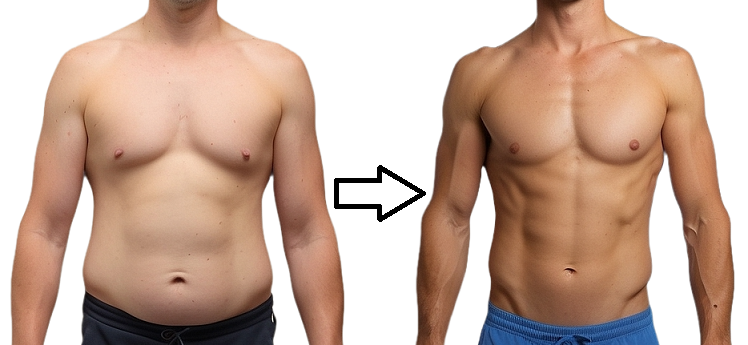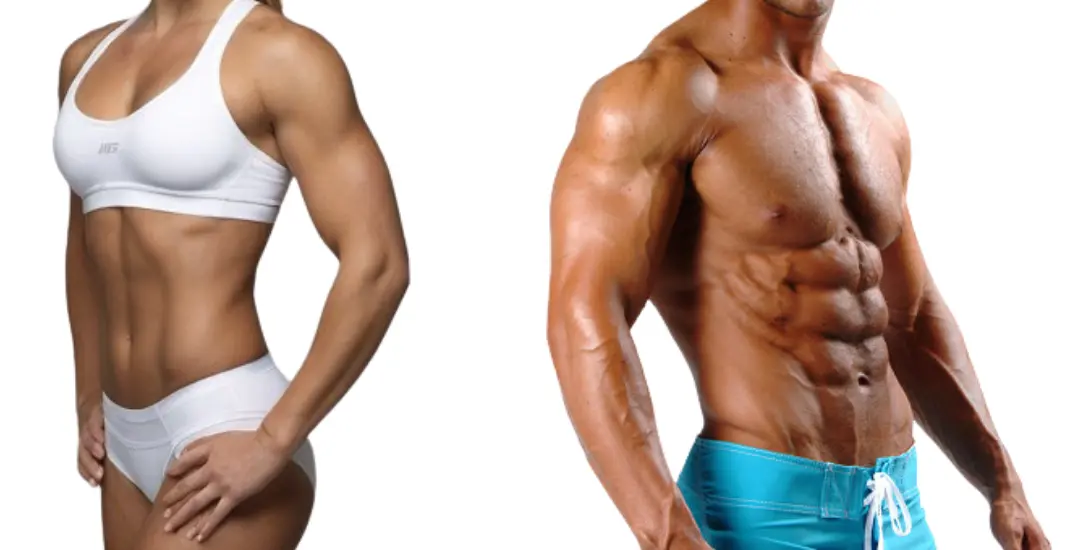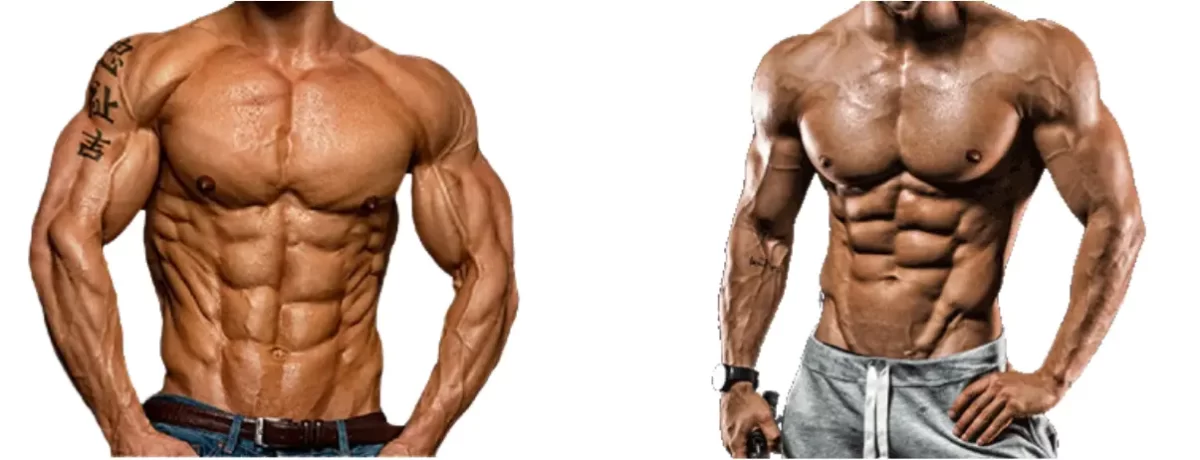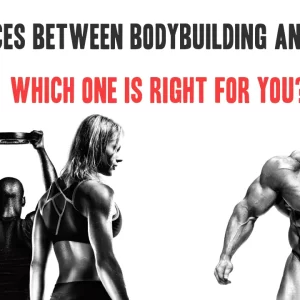Contents
Achieving a shredded and defined physique is a goal that many fitness enthusiasts strive for. It represents a level of dedication, discipline, and hard work that goes beyond simple weight loss. One key factor in reaching this pinnacle of fitness is understanding and managing your body fat percentage.
In this blog post, we’ll explore what it means to be “cut,” “defined,” “ripped,” and “shredded” in terms of body fat percentages. We’ll also delve into the differences between men and women in this context.
Understanding Body Fat Percentage
Body fat percentage refers to the proportion of your body weight that is made up of fat tissue. It’s a measure of how much of your body is made up of fat tissue, as opposed to lean body mass (muscles, bones, organs, etc.). It’s associated with various health risks. Excessive body fat, especially around the abdomen, can increase the risk of conditions like heart disease, diabetes, and certain cancers.
The ideal body fat percentage varies depending on age, sex, and individual goals. Athletes and highly fit individuals may have lower percentages, while higher percentages may indicate a need for weight loss and improved fitness.
Use a tape measure to determine your waist, hip and neck circumference. Then input your gender and measurements below to receive a body fat index based on average values.
Healthy body fat percentages
It’s important to recognize that healthy body fat percentages vary based on various factors, including age, gender, and activity level. While it’s tempting to strive for extremely low body fat levels for a sculpted appearance, it’s not always necessary for good health. Here are some general guidelines for healthy body fat percentages:
1. Healthy body fat percentages for men:
Healthy body fat percentages for men typically range from 6% to 24%, depending on factors like age and activity level. According to the American Council on Exercise (ACE), the acceptable body fat percentage for non-athlete adults is 18% to 24%, while the ideal range for those pursuing general fitness is 14% to 17%.
2. Healthy body fat percentages for women:
Healthy body fat percentages for women, like men, vary depending on factors such as age and activity level. For non-athletic women, an acceptable healthy range is 25% to 31%. For those pursuing general fitness, an ideal body fat percentage of 21% to 24% is recommended.
3. Healthy body fat percentages for athletes:
Athletes, especially those in sports where low body fat is advantageous, may have lower body fat percentages. For men, healthy male athletes may have body fat levels as low as 5-12%. For women, healthy female athletes can at times be as low as 12-20%.
4. Bodybuilders and Physique Competitors:
Competitive bodybuilders often aim for extremely low body fat levels, with male competitors possibly going as low as 4-6% and females around 10-12%. However, maintaining such low levels is typically unsustainable for long-term health.
| CLASSIFICATION | WOMAN (% FAT) | MEN (% FAT) |
| Essential Fat | 10-13 % | 2-5 % |
| Athletes | 14-20 % | 6-13 % |
| Fitness | 21-24 % | 14-17 % |
| Acceptable | 25-31 % | 18-24 % |
| Obese | 32+ % | 25+ % |
It’s important to note that these are general guidelines, and what’s considered healthy can vary from person to person. The key is to strike a balance between aesthetics, performance, and overall well-being. Extreme fluctuations in body fat can have negative consequences on health and quality of life, so it’s essential to prioritize sustainable and healthy approaches to fitness and body composition.
Cut, Defined, Ripped, Shredded: What Do These Terms Mean?
These terms – “cut,” “defined,” “ripped,” and “shredded” – are commonly used in the fitness and bodybuilding community to describe different levels of leanness and muscle definition based on body fat percentages.
Now, let’s dissect each of these terms to gain a deeper understanding of the nuanced levels of leanness and muscular definition they represent.
The images represent a low body fat percentage to provide an idea. As the body fat percentage decreases, the appearance changes based on the individual’s existing muscle mass. Consequently, achieving a completely clear view is not feasible.
Cut (12-15% Body Fat): Athletic and Toned

The “cut” phase typically represents the beginning of the process. Essentially, cutting involves a strategic approach to nutrition and training, aiming to create a caloric deficit, wherein the body burns more calories than it consumes.
When your body fat percentage falls between 12-15%, you will notice increased muscle definition. Muscles will become more visible, giving you an athletic and toned appearance. However, not every muscle group may be fully revealed at this level.
For Women: Women often aim for body fat percentages between 16-18% to achieve a cut appearance.
Defined (10-12% Body Fat):

Being “defined” takes the concept of cutting a step further. While a cut generally implies a reduction in overall body fat, being defined suggests a higher level of muscle separation and visibility. To be defined, you’ll need to lower your body fat percentage to around 10-12%. This level of leanness will reveal clear muscle separation and distinct muscle groups.
Achieving a defined physique involves not only losing excess fat but also emphasizing muscle symmetry and shape through targeted training. Your abs, for example, will become more prominent, and vascularity may start to show.
Defined for Women: Achieving a defined physique for women usually requires body fat percentages between 14-16%.
Ripped (7-10% Body Fat):

“Ripped” is a term commonly used to describe a state of extreme leanness, where muscles are not only well-defined but also prominently vascular. Achieving a ripped physique requires intense dedication and effort.
With body fat between 7-10%, your muscles will appear chiseled, and your veins will be more visible. This is often the level of leanness seen in bodybuilding competitions.
Ripped for Women: Achieving a ripped physique for women generally requires body fat percentages between 12-14%.
Shredded (<7% Body Fat):

When someone is described as shredded, it means their body fat percentage is exceptionally low, resulting in highly visible muscle striations and a sculpted appearance.
Shredded is the pinnacle of leanness, with body fat below 7%. Achieving a shredded physique demands a combination of strict nutrition, precise training, and often, advanced techniques such as water manipulation. Your muscles will be extremely pronounced, and your vascularity will be at its peak. Achieving this level of definition is often reserved for professional bodybuilders and elite athletes.
Shredded for Women: Going below 10-12% is considered extremely low for women and may not be sustainable or healthy for most. Low levels of body fat can disrupt the menstrual cycle and fertility due to hormonal imbalances (1).
Why Do I Have Low Body Fat But No Muscle Definition?
Your overall appearance is determined by your body composition, which includes both muscle mass and body fat. Muscles become more apparent as the layer of fat covering them decreases. Low body fat alone won’t give you a sculpted or muscular look if you don’t have enough muscle underneath. If your muscle mass is insufficient, you won’t see much definition, even with low body fat.
The “bulk and cut” approach is a common method used by bodybuilders and fitness enthusiasts to gain muscle mass first and then reduce body fat to reveal a more sculpted physique. In summary, your muscles will become more visible when you have sufficient muscle mass and a lower body fat percentage.
Conclusion:
Understanding the distinctions between being cut, defined, ripped, and shredded provides insight into the journey that fitness enthusiasts undertake to achieve their desired physique. Each stage requires a unique combination of nutrition, training, and discipline, showcasing the dedication it takes to sculpt a body that reflects both strength and aesthetic appeal.
The key to achieving a sculpted look lies not only in reducing body fat but also in developing an adequate amount of muscle mass. Whether your goal is to be cut, defined, ripped, or shredded, it’s crucial to approach your fitness journey with patience, consistency, and a commitment to overall well-being.



